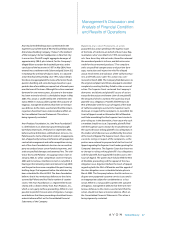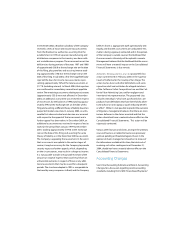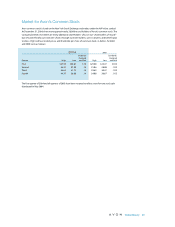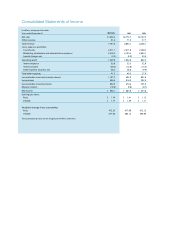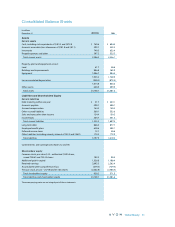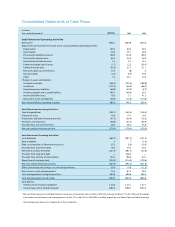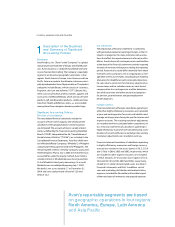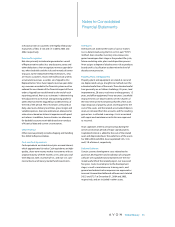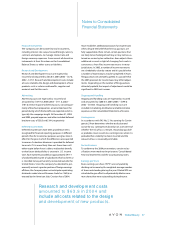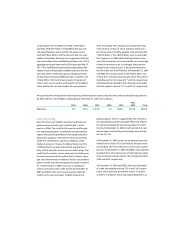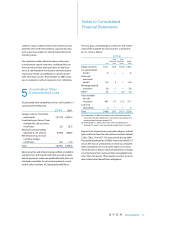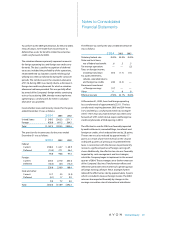Avon 2004 Annual Report Download - page 34
Download and view the complete annual report
Please find page 34 of the 2004 Avon annual report below. You can navigate through the pages in the report by either clicking on the pages listed below, or by using the keyword search tool below to find specific information within the annual report.
Global Beauty 55
at historical rates in countries with highly inflationary
economies of $0.0, ($1.0) and $.7 in 2004, 2003 and
2002, respectively.
Revenue Recognition
Net sales primarily include sales generated as a result
of Representative orders less any discounts, taxes and
other deductions. Avon recognizes revenue upon deliv-
ery, when both title and the risks and rewards of owner-
ship pass to the independent Representatives, who
are Avon’s customers. Avon’s internal financial systems
accumulate revenues as orders are shipped to the
Representative. Since Avon reports revenue upon deliv-
ery, revenues recorded in the financial system must be
reduced for an estimate of the financial impact of those
orders shipped but not delivered at the end of each
reporting period. Avon uses estimates in determining
the adjustments to revenue and operating profit for
orders that have been shipped but not delivered as of
the end of the period. These estimates are based on
daily sales levels, delivery lead times, gross margin and
variable expenses. Avon also estimates an allowance for
sales returns based on historical experience with prod-
uct returns. In addition, Avon estimates an allowance
for doubtful accounts receivable based on an analysis
of historical data and current circumstances.
Other Revenue
Other revenue primarily includes shipping and handling
fees billed to Representatives.
Cash and Cash Equivalents
Cash equivalents are stated at cost plus accrued interest,
which approximates fair value. Cash equivalents are high-
quality, short-term money market instruments with an
original maturity of three months or less and consist of
time deposits with a number of U.S. and non-U.S. com-
mercial banks and money market fund investments.
Inventories
Inventories are stated at the lower of cost or market.
Cost is determined using the first-in, first-out (“FIFO")
method. Avon classifies inventory into various cate-
gories based upon their stage in the product life cycle,
future marketing sales plans and disposition process.
Avon assigns a degree of obsolescence risk to products
based on this classification to determine the level of
obsolescence provision.
Property, Plant and Equipment
Property, plant and equipment are stated at cost and
are depreciated using a straight-line method over the
estimated useful lives of the assets. The estimated useful
lives generally are as follows: buildings, 45 years; land
improvements, 20 years; machinery and equipment, 15
years; and office equipment, five to ten years. Leasehold
improvements are depreciated over the shorter of
the lease term or the estimated useful life of the asset.
Upon disposal of property, plant and equipment, the
cost of the assets and the related accumulated depreci-
ation are removed from the accounts and the resulting
gain or loss is reflected in earnings. Costs associated
with repair and maintenance activities are expensed
as incurred.
Avon capitalizes interest on borrowings during the
active construction period of major capital projects.
Capitalized interest is added to the cost of the related
asset and depreciated over the useful lives of the assets.
For 2004, 2003 and 2002, Avon capitalized $2.5, $1.6
and $1.0 of interest, respectively.
Deferred Software
Certain systems development costs related to the
purchase, development and installation of computer
software are capitalized and amortized over the esti-
mated useful life of the related project, not to exceed
five years. Costs incurred prior to the development
stage, as well as maintenance, training costs, and
general and administrative expenses are expensed as
incurred. Unamortized deferred software costs totaled
$65.5 and $73.7 at December 31, 2004 and 2003,
respectively, and are included in other assets.
Notes to Consolidated
Financial Statements




